How I Have Been Successfully Canning Without The Waterbath Method
I have been successfully canning jams without the water bath method. Here’s my process, my background, and some science behind it.
Yes, you read that right! In over 30 years, I have never water bath canned my jams – and I probably never will.
I understand that that statement could make some of you very uncomfortable. You might be thinking, but what about botulism?
In this article, I will share with you my process, my background, some science, and some resources. Then you can educate yourself and decide what you are most comfortable with.
Disclaimer: Both the FDA and USDA recommend how water processing for jams. Please do your own research and make decisions accordingly.
So why can without a water bath?
That is a very good question!
- First of all, it’s just a habit. I had been watching both my grandmother and my mom making jams. They used the no-water bath can method all along. So in a way that is what I have witnessed and what I grew up with.
- Then, canning without the water bath method saves time. You see, often I make a few jars of jam in between some other activities.
- And lastly, I am certain that you will lose vitamins when you’re adding another 10-15 minutes of high-heat water processing.
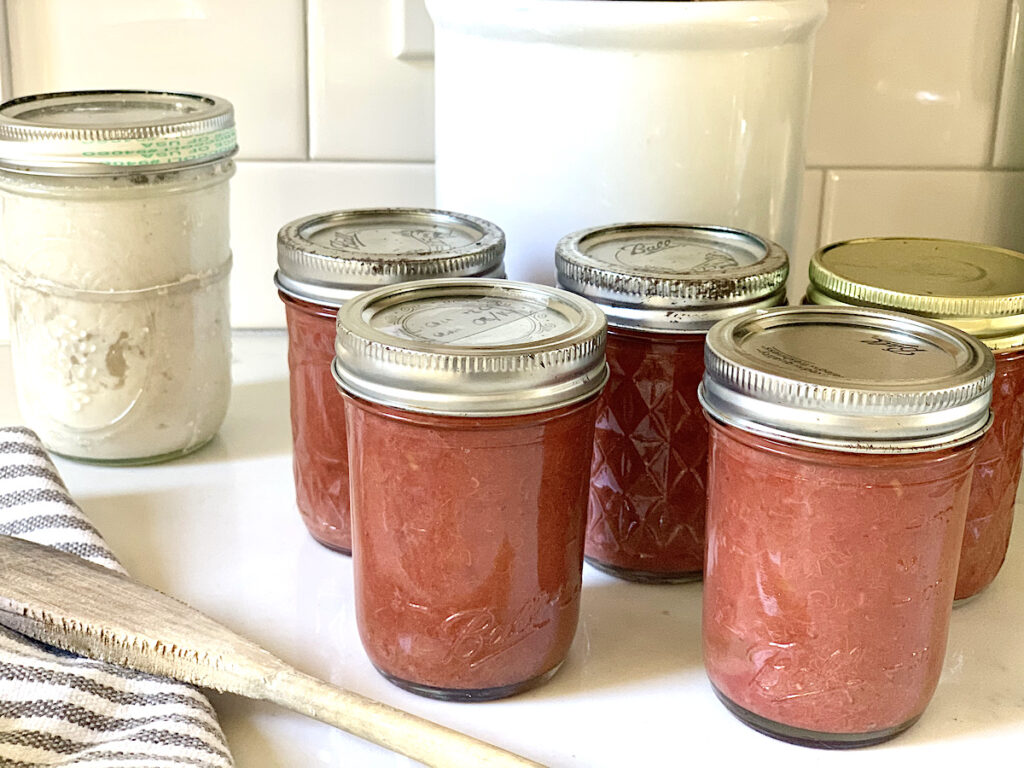
My jam canning process
This is the method that I always use:
Sterilize the jars
First, I sterilize the mason jars in either a pot of boiling water for 10-15 minutes or do that in an oven set to 200˚-250˚ F for about the same time.
Clean, select, and boil the fruit with sugar and lemon juice or citric acid
In the meantime, I boil my cleaned, picked, and potentially cut fruit for 3-5 minutes with the appropriate amount of sugar and some lemon juice or citric acid. Depending on the time I have and the fruit I am using, I might add some pectin.
Fill the hot jam into the hot jars
Then, I fill the hot jam into the hot jars, leaving about ¼ inch of space at the top of the jar. I tightly put on the lids and the bands.
Put the lid and the band on tight
Next, I put the jars on their head for 5 minutes. After that time, I set them upright again and let them cool down. Before I store them, I make sure all of the jars have good seals. Often, I can hear when that happens. But also, when you press on the lid with your finger, there should not be any give.
Put the jars on their head for about 5 minutes
After 5 minutes put the jars upright again
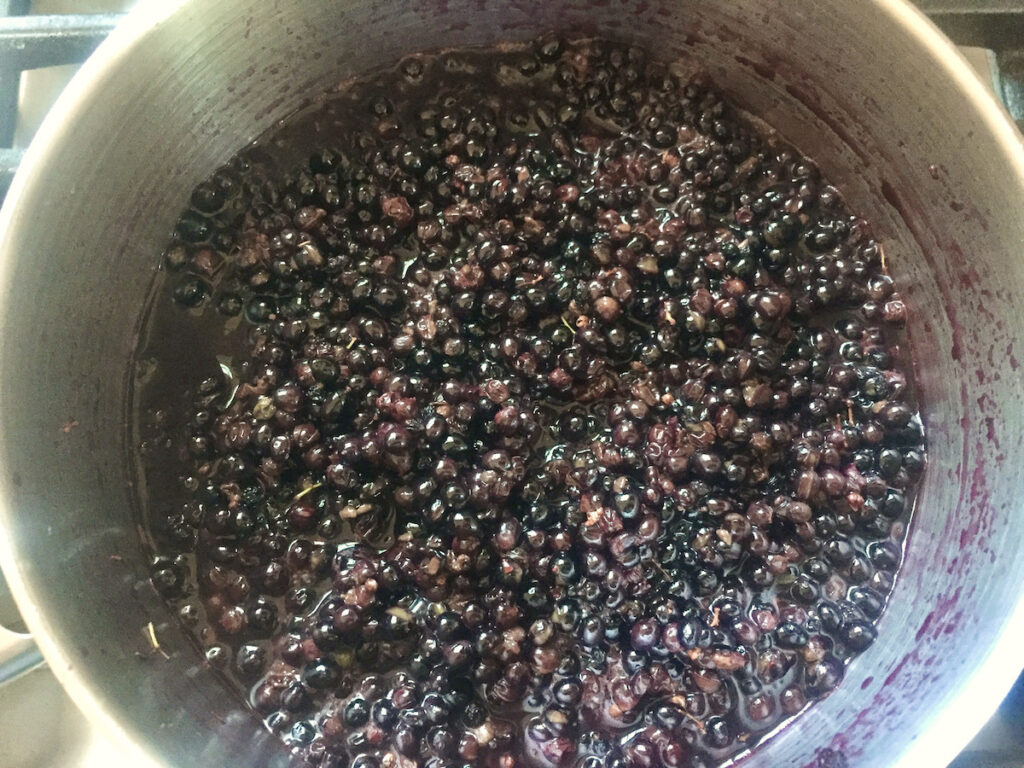
My background
If you’ve been following me, you might know that I grew up in Germany. Everybody cans their jams this way there and I haven’t seen anyone use the water bath method.
How Europeans make jam
For example, I have a friend who likes to buy just a couple of pounds of fruit at the farmer’s market when it’s in season and on sale. While making dinner, she might make the jam, and fill a few jars at a time. She does that several times a season rather than embarking on longer canning sessions.
Canning in the US vs Europe vs Overseas
When I came to the US, I soon realized that everyone was water bath canning their jams, just like the USDA and FDA recommend. But I also thought that this method was somewhat particular to this country. I think most European countries and New Zealand for example use the no-water bath canning method.
On a recent trip to Germany, I wanted to find out more. So I went to a local farmer’s market and talked with a commercial jam seller. I asked him if the hot water processes his jams. He looked at me somewhat incredulously, only to tell me that he had never done that in all the decades he had been making jam.
In my research, I went to the website of a popular German baking product website that also has a lot of canning recipes. None of the recipes that I saw included a recommendation for hot water processing. They have an English website but that does not have any canning recipes.
Furthermore, I checked my antique cookbooks, both American and German. While that may not necessarily be authoritative, I thought it might give me some clues. None of them seemed to be particularly concerned with food safety, making me believe that botulism is in fact pretty rare.
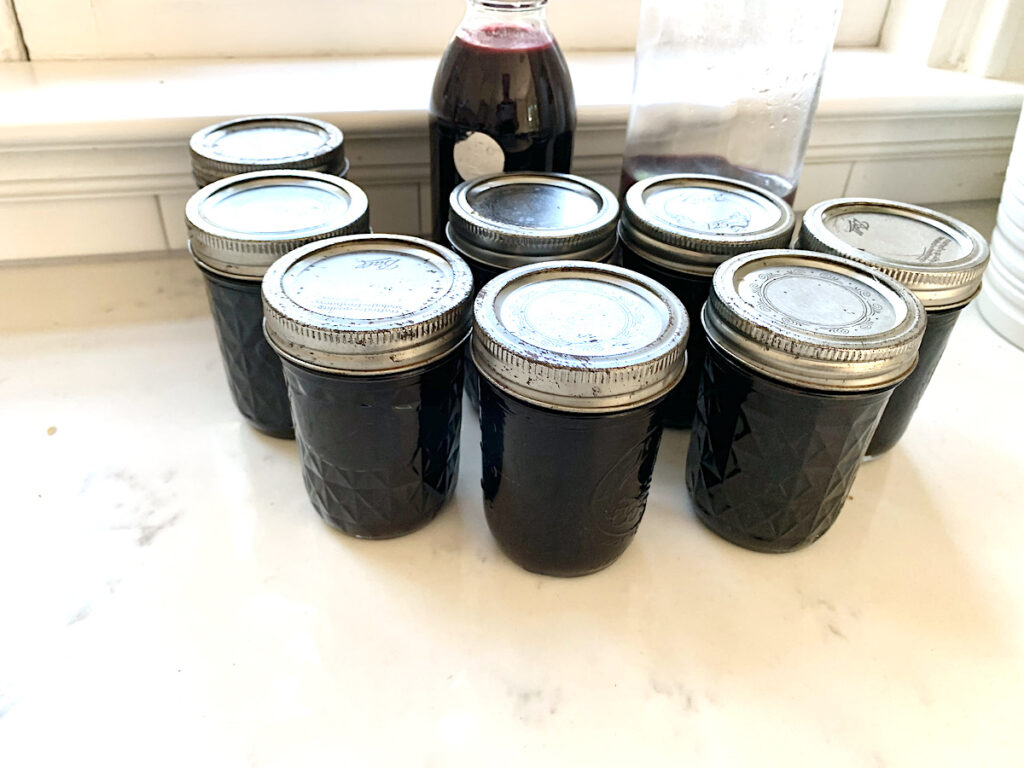
What is the concern with jams and the no-water bath canning method?
The main concern when you use the no-water bath canning method is botulism. Under certain circumstances, it can grow in your jams and preserves. When it does, it can cause severe illness and potentially death.
However, in my research on this topic, I learned that in 2017 for example, the CDC only reported 182 cases of botulism. This is a stark contrast to the 1.35 million yearly cases of salmonella. So botulism is a pretty rare occurrence and disease.
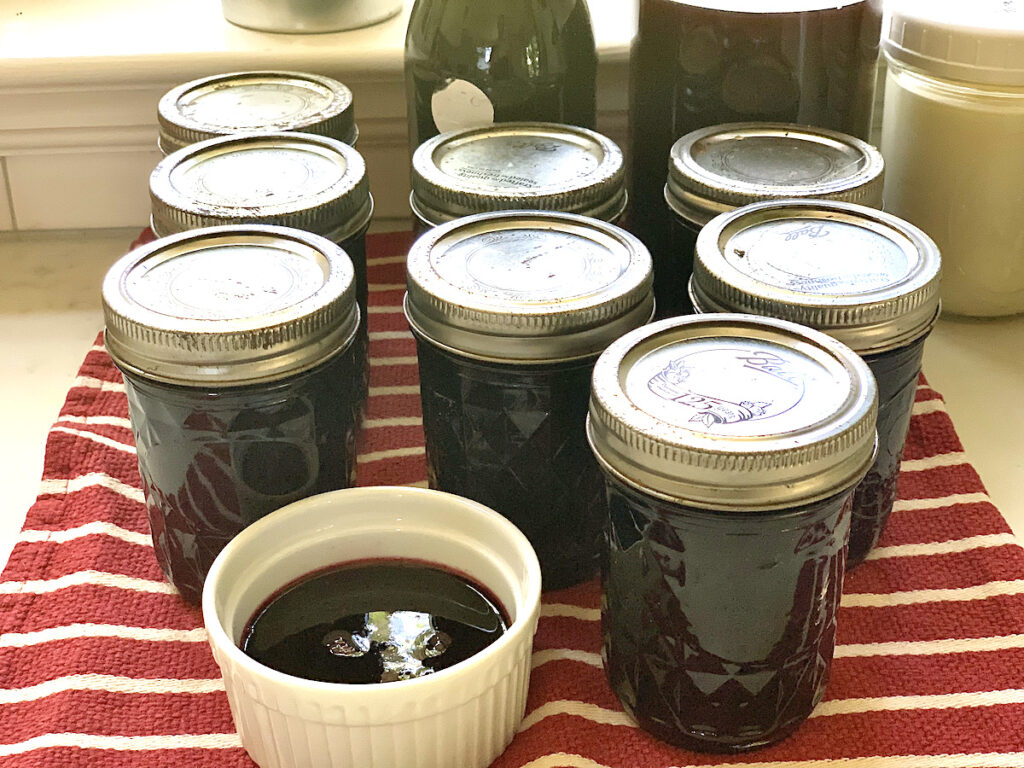
The science behind canning jams and preserves
So what I am doing in order to prevent the growth of any bacteria, mold, or botulism while I am using the no-water bath canning method?
- Well, as I mentioned above, I sterilize my jars in either hot water or my oven.
- I also like to add quite a bit of sugar as that acts as a preservative. With the addition of lemon juice or citric acid, I am lowering the pH of the jam, especially in low-acid fruits such as blueberries.
- I fill the jars almost to the top and make sure to create a good seal. This is something I check when opening a jar (if the lid comes off too easily, it wasn’t properly sealed).
- Lastly, I understand science in that protein needs to be available for botulism to grow. Fruits don’t typically contain any protein at all. Therefore, I would not use the no water bath canning method for canning meat or beans or foods with protein in them.
- Now, if in doubt you could check the pH of your jam with either pH strips or a pH meter. Simply put some of the jam in question on a spoon or in a small bowl and test it there according to the directions.
So, I am thinking that the hot water processing recommendation is just another safety measure to basically rule out any chance of botulism.
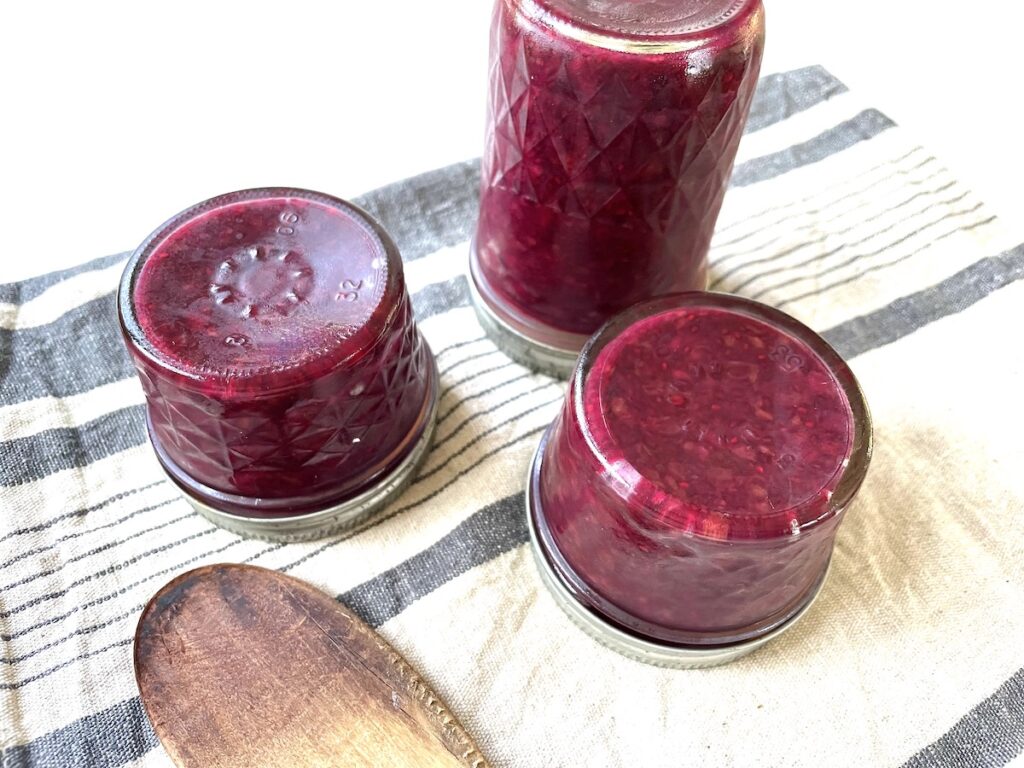
More resources
Below, I am linking several resources that I find interesting. Again, I encourage you to research and educate yourself and use your best judgment.
A Washington Post article on this topic: https://www.washingtonpost.com/food/2021/08/26/jam-canning-safety-water-bath/
How Sugar Preserves: https://www.scientificamerican.com/article/how-do-salt-and-sugar-pre/
Study on low pH to prevent botulism: https://pubmed.ncbi.nlm.nih.gov/39257/
German strawberry recipe: https://www.oetker.de/rezepte/r/erdbeer-konfituere
German video on jam-making: https://www.youtube.com/watch?v=y01ysaT7Yjo
Shop this post:
pH meter: https://amzn.to/3Dso3iT
pH test strips: https://amzn.to/3mIWcVU
Mason jars: https://amzn.to/3mPWpqi
I would love to hear all your -kind- comments and questions so that we can all learn from one another!
Pin For Later:
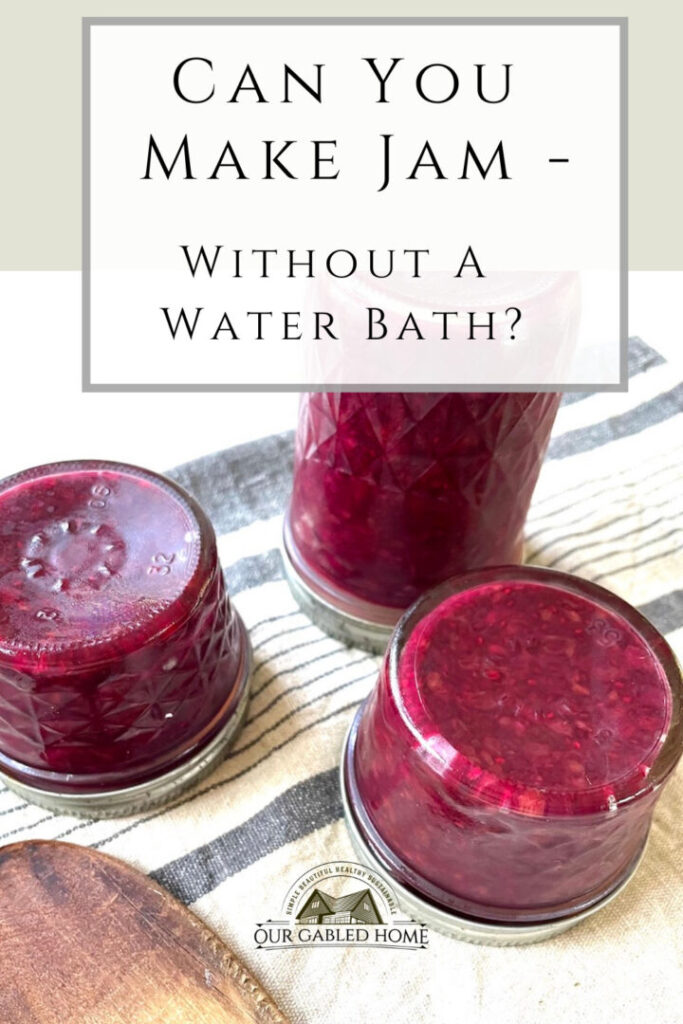


I came here via doing a search, why do people water bath jelly lol. I’d been looking for sandcherry jelly recipes & all the recipes are doing water bathing jam & jelly ! I’d never heard of such a thing. All the women in our community never did nor do this. There were meats & certain veggies that they water bathed but never jam & jelly.
We sterilize jars in the oven. Placing jars in a 250 oven in a long pan , then we pour boiling water over the jars so that there’s maybe 1/4 hot water in each jar. I was told that this prevents jars from cracking, so we never leave the jars in the oven dry. We bring jars out a few at a time & fill. Lids are kept on the stove top in a pot of boiled water that is simmering. ..we know if the jars are sealed both by the pop of the lid & by touch. Any random unsealed jars just go into the fridge & eaten fairly quickly. I don’t know if non water bath technique is cultural or just the practice of the time because our community is very diverse Icelandic Arab Metis UK
I do know that in over a century there hasn’t been a single case of botulism recorded or reported. I’m not about to add hot bathing my jelly anytime soon lol
Yes to everything you said 😉 ~ Anja
I would like to add a reason for leaving the rings on when storing sealed jars.
I have had the occasional lid fail (maybe 2 out of over 300, and those probably happened early on as I was learning the technique).
The “smell” is what sent me hunting for the source, and I found the jar with the failed lid–but it wasn’t obvious. I followed my nose… And of course the lid also moved down when pressed.
Leaving the ring in place will make it harder to find the loose lid, BUT it will prevent a lid from “blowing” off and making a larger mess if contamination inside is active enough.
Having writ this, I leave the rings off because they seem to rust more than the lids in my basement.
Incidentally, I re-use lids–multiple times DESPITE the “very grave” warnings from the usual suspect agencies. “If they seal, they work.” Try it. Huge money-saveer.
That makes sense and thank you for sharing ~ Anja
Hi there,
My ussr raised mother always canned this way and this is the only way I’ve made jam too. My question is why the flipping? We have never flipped our jars and leave the top nice and clean; what is the advantage in the flips? Thank you
I guess the tipping the jars is more of a habit than a necessity ~ Anja
What an amazing thing to read, especially with Christmas gifts needing to be made, and I sold my water bath canner when we moved out of state.
I can’t wait to try this with quince jelly (your recipe!) and blackberry jam and apple sauce and apple butter and…!!! Thank you sooo much for sharing this time saving, time honored method of preserving!
I am so glad you enjoyed this post! Happy canning and happy holidays ~ Anja
I have canned, a little bit of everything for at least 45 years and my maternal grandparents were German, and this is the way they and my mom always canned, jams and jellies, but as another one mentioned they also used the wax for sealing. Which I have always done. I just shave the wax with a grater.,put a good amount on top then add the lids seals, all sterilized..this method might not be for everyone, but I know they did not always use jelly jars like we have today. And the wax seal still worked. Just cover jars after cooling with foil, cloth etc, helps keep dust out. Of course Amy thing else I use water bath etc. Thanks for your post. Could not find much about doing jams, jellies this way. So glad I’m not the only one doing it the old fashioned way.
Nice! Thank you so much for sharing the wax method and for your nice comment ~ anja
Would this process also work with tomato products if vinegart/acid is added?
Yes, I would recommend adding lemon juice or citric acid ~ Anja
I made grape jelly for the first time last weekend. I was reading in a Ball canning book and it did not suggest canning the jelly in a water bath. I was very surprised. Did a little searching online and saw some who did and some who didn’t. I decided not to water bath as I didn’t want to cook out any more nutrients than I already had. I did put my sterilized jars upside down, but probably only for a minute. All 13 of my jars sealed and even heard them pop! I’m glad to see that many people for many years have done the same successfully. I used not quite 3/4 cups of sugar for each cup of grape juice. And I used the juice of one lemon for every 4 cups of grape juice. I figure between the sugar and the lemon and the jars being sealed, that it should all be fine! Thanks and God bless! Dawn
Sounds great and thank you so much for sharing ~ Anja
Does this process work with apple sauce?
I’m so glad to finally see a post on no-water bath preservation.
Now I’m just looking for techniques on preservation for different preserves, veggies, meats, etc.
As long as the pH is low enough (you can add lemon juice and/or citric acid) ~ Anja
I grew up in Germany Bavaria and my mother always used a water bath method. I never heard of any other way. Really interesting. How long can you preserve food this way? I usually just freeze small amounts.
I have jams that are a few years old 🤷♀️ ~ Anja
There is so much confusing data on the subject. Especially for people like me who love sharing what I have made. This post set my mind at ease. This is the way I have always canned my vegetables and preserves.
The problem I have is my jams and jellies often don’t set up. I end up with lots of compotes 🙂 Do you have a suggestion that might help me in this?
To make your jams and jellies set more, either increase the amount of pectin or cook them longer ~ Anja
Bless you for posting this. I have always used the water bath method and thought what a pain in the butt it was. NO MORE. I am going to use your method in the future, it uses much less water and power and most of all my time!
I am so glad to hear that!
My Mother and Grandmother always made jam the way you have suggested, and all North American heritage. I was brushing up on jam making as I hadn’t done it for awhile and was surprised to find out after googling that a water bath was recommended. I was very glad to come across your post confirming it was OK to preserve jam without a water bath. Thanks for sharing the post.
I am so glad to hear you enjoyed this post on jam making ~ Anja
My Slovenian mother as well as my Serbian and German grandmothers made jams and compotes all their lives and never used a hot water bath. They did just as you described. Not sure they even sterilised as thoroughly as you do. They just washed and then poured boiling water over everything. Botulism needs a pressure canner to kill any spores. Hot water bath isn’t enough. But as far as I know it can’t survive in a sweet and acidic environment so jams should be safe.
I’ve also noticed that hot water baths are almost unheard of in Germany. And nobody freaks out about soft boiled eggs or even raw eggs in tiramisu unless it’s for an immunocompromised or elderly person.
Yes and thank you so much for sharing ~ Anja
I make pickles and do not water bath ever. These last a year in my basement. I have had some that are over a year old. Also, I have applesauce in jars in the basement and those were not water bathed either. I always make sure the jars, lids, rings and the food going into the jars is super hot. Also, I do not touch the lids or the rim of the jars with my fingers. I believe that is how the germs are added to canning. I do not water bath jam or jelly ever. I have been canning for 35 years.
Sounds great! Thank you so much for sharing ~ Anja
Will this method also work if using alternative sweeteners such as Monkfruit or Allulose? I need a sugar free version. I did use lemon juice also.
I am not sure if alternative sweeteners are safe for canning this way. You might want to do some more research ~ Anja
Hello, I have a question when sterilizing mason jars in the oven at what temperature is it safe? My mother has always done it at 200° and she never had any problems. Can I go higher than that thank you.
Yes, you can sterilize them in the oven at 200˚F since Weck jars are heat-proof up to 400˚F (200˚Celsius) ~ Anja
Do you leave the rings on the jars? After waterbed canning, many people take the rings off and just leave the lids. I would think you’d need to leave them on or risk popping open the seal when you remove them.
Officially, the rings are supposed to ensure a good seal but once you have reached that you shouldn’t need to have them on. People like to take the rings off to see if the seal is intact (if it’s not or of there is a problem with the jam, the lid will be loose). Hope this helps ~ Anja
I really enjoy your posts, Anja! Your sourdough advice and method has been invaluable. I, too, have canned jams this way. For safety, I do think it is important to note that canning other food items requires processing, sometimes with a pressure canner, depending on the food item. Thanks for all your tips and recipes.
Yes, thank you for mentioning that! I have another post in which I talk in more detail about the pH and type of foods that are safe to simply fill into hot jars: https://ourgabledhome.com/how-i-have-been-successfully-canning-without-the-waterbath-method/ ~ Anja
What about sauerkraut without water bath
Sauerkraut will keep on its own in a cool place, probably around 6 months. I have not canned it myself since I like it for all the probiotics which will be lost during the heating process ~ Anja
Writing here from Lithuania. No one in my lineage also water bathed jams.
I use pretty much the same method you do, except I do not put any extra sugar in my jams. And they hold great. Only ever encountered problems, when I put the jams in cold jars. Even then, typically it would fine, but maybe every 15th jar would “pop”.
I also use this method in canning slightly acidic vegetable stews. Also works great.
Would really love to be able to can non-acidic stews with grains though. So I’m thinking of experimenting with water baths. Fingers crossed I’ll find a way. As far as I have read to this day everyone seems to be advising against it though. 🙂
I’d be careful with non-acidic stews. You might like to read my other article: https://ourgabledhome.com/botulism-and-how-to-can-at-home-without-fear/ Thank you for sharing and I hope this helps ~ Anja
My concern with water bath canning after boiling the jelly, is you are only supposed to boil it for a set amount of time or the pectin may not set right. Water bath canning would extend the high heat of the pectin and then would they not set right?
Since I don’t use a water bath, I am not sure ~ Anja
I learned a lot from Steffi Kocht Ein YouTube channel. She went in great detail about botulinum- from the German prospective rather than the super “safe” USDA method (videos are in German). Based on that series of videos as well as her tips about preventing mold in applesauce without waterbath canning, I think the main issue with not waterbath canning is the risk of mold. But if you fill the jars super hot, so that the temp stays over 80 degrees Celcius, and then turn them upside down, I think you could prevent the mold.
I love Steffi from SteffiKochtEin and love to listen to her videos! Thank you so much for sharing ~ Anja
Glad I found you…this is a game changer for me when making jelly.
But my question is can I do this with a cranberry relish that doesn’t require heating? I make it by blending cranberries, oranges and sugar. I just don’t want to water bath it because I don’t want it cooked but I don’t think there’s a way around heating up the relish in order to can it. From what I’m seeing I have to heat/cook the relish, then do your method, right?
Yes, you always want to boil whatever you are canning. I am assuming your relish will stay fresh for a bit in the refrigerator, though. Hope this helps and thank you for your nice comment ~ Anja
Can I use this process for pickling vegetables? I have used it for making apple sauce and also for pickling vegetables in a vinegar brine and also a salt brine, but just wanted to double check. Thank you.
I am not 100% sure about pickling but with the addition of salt or vinegar that *should* work ~ Anja
Thank you for this post!
I have a tiny oven & like to minimize use of any fuel (electricity, gas, firewood), and was wondering what you thought about sterilizing jars & lids with alcohol instead of boiling in hot water or baking them in the oven? It’s quicker, easier, and more environmentally friendly. The Japanese sterilize with shochu (undistilled 20% alcohol) during their miso-making.
Also, I would prefer to use apple cider vinegar instead of citric acid, just because it’s an organic food-grade ingredient that’s in my kitchen already. What are your thoughts? Thank you for your time & consideration.
I often just run my jars through the dishwasher and use them that way. You could use ACV but even citric acid is not strictly necessary. I often add it for extra tartness and to keep the nice color of the fruit ~ Anja
Would it work to make tomato sauce?
I have been doing it for years with salsa, just wondering now would it work for tomato sauce?
As long as the pH is low enough. You can always add some citric acid which will also keep the nice red color ~ Anja
After 50 years of making jelly and jam, I finally made my first rhubarb jam. That led me to reading the instructions and seeing this ‘water canning’ instructions. Wow! I’ve been doing it wrong for 50 years and never had a jar go bad. Go figure. LOL
BTW, I added cinnamon to the second batch of rhubarb jam and I think it’s going to be a winner. 🙂
Nice! Sounds like you have been loving your jams just fine ~ Anja
I have never used the water method for jams and jellies and have never, ever had any issues – provided of course the jars have been sterilized (I use the dishwasher, followed by at least 30 mins in a 200-250F oven). I also boil my lids, sealer rings, funnel and ladle.
I *do* however use the water bath canning method for anything that includes garlic and onions (e.g. my salsa) as well as for tomatoes and peaches/pears/spiced crabapples.
I keep my preserves for up to 2 years, although they rarely last that long!
Yes! I, too, would further process anything with low pH vegetables in it ~ Anja
I have been canning my homemade salsa for over 25 years. The recipe I was given to me from a 70 year old lady that has done it this way all of her life. I cook my salsa and add vinegar, some salt and sugar and place in sterilized jars from a 200 degree oven and lids from boiling water. I have never had a problem.
Sounds great and thank you for sharing ~ Anja
Excellent article confirming the steps for making jams and jellies that I learned from my mother and grandmother. We have canned this way for generations with no issues.
Nice! Thank you for sharing and commenting ~ Anja
Could this same method be used to can fresh salsa???
That would depend on the pH of your salsa, i.e. how much vinegar you have in it. If in doubt, I would process it in a water bath or pressure canner. Hope this helps ~ Anja
Yes I have been doing it with my grandmother’s salsa recipe for decades now.
Nice! Thank you for sharing ~ Anja
I also follow how my German mother did it. No water bath for jams, beets and the sugar and vinegar peppers ( my favourite canned peppers) Everything should just be hot and sterile. Although I haven’t canned in awhile, thanks for confirming I’m still doing it right. 😉
Yes, that is the way Germans have been doing it all along. With jams, this method is pretty safe ~ Anja
Lily, so when you say canned beets, I presume those are pickled? I have been hunting for a recipe for non pickled beets that don’t need a pressure cooker. And what exactly are sugar and vinegar peppers? I tried to Google them to finda recipe, recipe but can’t find one. Thanks!
I, too have never used a water bath for my high acid canning items. Pickles, berry jams, relish, chow chow…all can be done with no water bath. I invert the jars for about 15 minutes. I canned for many years but it’s been a few years since I last canned. In looking up info for refresher I saw the water bath and didn’t remember using it so I was glad to find your article about not needing it. I thought maybe I was remembering wrong but nope…I’m golden!! Thank you!!
Nice! I am so glad you found this information helpful. Happy canning ~ Anja
Can you use trivia, stevia, or a stevia blend instead of sugar?
You will need the sugar so that the pectin can form a gel. Otherwise, your jams will not set. You can either use less sugar and add stevia to increase the sweetness or use a no-sugar pectin ~ Anja
Hello. I am a southern girl from Mississippi. I too do not use a “water bath”. Never have nor my mother nor her mother. So I never understood the need for the water bath process. We have always canned fruits and vegetables by your process. The only difference is that we would heat the lid with rubber in a pot of boiling water just before placing on jar. Never lost any food and never went bad. Thanks for the article
Thank you so much for sharing your traditional ways ~ Anja
I’m from Texas and that’s the same way I do it…just like my mother and her mother and her mother…lol
Nice! Thank you for sharing ~ Anja
Very interesting reading, thank you! It answers a lot of my questions.
I’m relatively new to jam making, although I watched my Granny do it many times growing up. We never had any issues with illness or spoiling. I’m in Australia, and have always done it the way you do (sterilise jars first (I boil first, then dry in oven), add filling while everything is hot, turn upside down, check lid indented/firm for vacuum). I had always thought this meant air was excluded. Plus the preserving effects of the sugar (or vinegar in the case of savoury) helps. I have been intrigued by the recommendations to use the water bath after filling in some online recipes. My impression is that it seems to be an American thing. I thought it might make the jars explode, putting them under water and boiling again but perhaps not! Thanks again for the insight and information.
Hi Fran, in my personal opinion (please do your own research) both the American FDA and USDA are VERY conservative agencies that recommend practices that are essentially fool-proof. I will publish another post and video soon about this topic and how to know if you actually might have botulism in your jams so stay tuned for that ~ Anja
Can you use weck jars with this method?
Yes, you can, just make sure to leave little headspace and heat up the lids and rubber rings in hot water before putting them on ~ Anja
This was my first year canning anything. I used the water bath method for all my jam, but then heard about this method later on! This is so fascinating and I found your post so insightful. Thanks for sharing!
Thank you and I am so glad you found this helpful! Happy canning ~ Anja
I didn’t know you that you could make canned jam without a water bath. I love this post. Your posts are so thoughtful and detailed. You really do make me feel like I take on any of your recipes with such ease. Thanks for sharing.
I have never heard of canning without a water bath before. What a time and energy saver! I’ll need to try this out the next time I make jam.
I have been canning 50-ish years. My grandmother and mother used the no-water bath method for jams/jellies too. They also used wax to seal jars but that is waaay to messy for me. In reality the government agencies haven’t actually tested “anything” since around the ’50s or ’60s. They just keep repeating themselves, covering their on rears! They say steam canners are not safe. Why? Because they haven’t taken time to test them because the government doesn’t give them money for new research. When making small batch jams/jellies it is a serious time saver to kick the waterbath canner back to the closet and perfectly safe as long as like you said “steralize properly”.
Thank you, Tina 🙂
We used to make jams years ago by sterilizing the jars and utensils, just like you do. Now however I do recommend water bath canning, as a safety precaution for further preservation. You have a good question about the possible reduction in vitamins with the further exposure to heat. It’s all food for thought. Thanks for a great post!
I have an apple tree with sour apples at my new house. I was thinking of canning some apple jam. Do you think this method would be ok for that? Should I add lemon juice? Do you use this method with American ball jars?
I have always wondered why some recipes call for water bath canning jams and some don’t. Thank you for clearing this up using science and some resources to support your method. I will definitely use this as a personal canning resource.
Thank you for commenting and happy canning ~ Anja
What if you don’t want to use sugar?is there another option?
It depends on whether you want some added sweetness or not in your jams. If you’re looking for sugar alternatives, you could use grape juice or apple juice. You can make jams without any added sweeteners but I recommend adding a bit of citric acid.
Have recipe for salsa handed down…lids sterilized in hot water on stove and washed, wet jars 5 minutes in microwave…salsa boiled with apple cider vinegar added and placed in jars while all hot…then flipped over. Been doing this for years. Wondering pickles could be done same way as long as vinegar is added. Thoughts? TIA
Sounds good to; me as long as you have enough vinegar the pH should be low enough ~ Anja